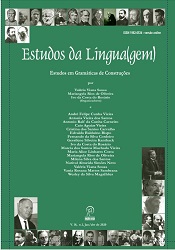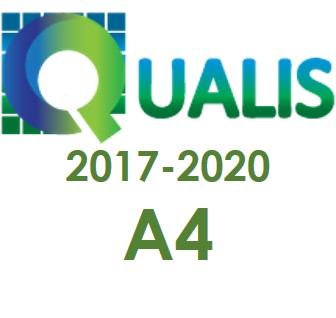Neonálise e analogização na formação de marcadores discursivos do português (Neoanalysis and analogization in the formation of discursive markers of Portuguese)
DOI:
https://doi.org/10.22481/el.v18i1.6126Palavras-chave:
Neonálise. Analogização. Marcadores discursivos. Construção gramatical.Resumo
Descrição e análise de contextos de uso, nos termos de Diewald e Smirnova (2012), que levaram à convencionalização da construção marcadora discursiva formada por elemento verbal de sentido visual e elemento afixoide opcional, codificada no esquema [Vv(X)af]MD. Com base na LFCU, nos termos de Traugott e Trousdale (2013), Bybee (2010; 2015), Hilpert (2014), entre outros, em viés qualitativo, a referida construção é abordada em termos hierárquicos, a partir do cline esquema > subesquema > microconstrução. Para tanto, selecionam-se três types específicos: olha, olha lá e olha só, representantes, respectivamente, dos subesquemas [Vv]MD, [VvLocaf]MD e [VvFocaf]MD. Como resultado de nossa investigação, constatamos que neonálises de distinta natureza, tanto micropassos quanto analogização, concorreram, na trajetória da língua, para a configuração da rede desse esquema, ampliando o paradigma dos MDs do português.
Downloads
Referências
BECHARA, E. Moderna gramática portuguesa. 37ª Edição. Rio de Janeiro: Nova Fronteira, 2015.
BOOIJ, G. Construction morphology. Oxford: Oxford University Press, 2010.
BOOIJ, G. Morphology in construction grammar. In: HOFFMANN, T.; TROUSDALE, G. (eds.). The oxford handbook of construction grammar. Oxford: Oxford University Press, 2013, p. 255-273.
BYBEE, J. Mechanisms of change in grammaticization: the role of frequency. In: JOSEPH, B.; JANDA, R. (orgs.). A handbook of historical linguistics. Blackweel, 2003.
BYBEE, J. Language, usage and cognition. New York: Cambridge University Press, 2010.
BYBEE, J. Language change. Cambridge: Cambridge University Press, 2015.
CROFT, W. Radical construction grammar: syntactic theory in typological perspective. Oxford: Oxford University Press, 2001.
DIEWALD, G. A model for relevant types of contexts in grammaticalization. In: WISHER, I.; DIEWALD, G. (eds). New reflections on grammaticalization. Amsterdan: John Benjamins, 2002, p. 103-120.
DIEWALD, G. Contexts types in grammaticalization as constructions. In: Special volume 1: Constructions all over – case studies and theoretical implications. Dusseldorf, 2006. Disponível em: www.constructions-online.de:009-4-6860. Acesso em: 10 de mar. 2019.
DIEWALD, G; SMIRNOVA, E. “Paradigmatic integration”: the fourth stage in an expanded grammaticalization scenario. In: DAVIDSE, K. et al (eds). Grammaticalization and language change – new reflections. Amsterdam/Philadelphia: John Benjamins, 2012, p. 111-131.
FISCHER, O. Grammaticalization as analogically driven change? Vienna English Working Papers, vol. 18, n. 2, p. 3-23. 2009.
FURTADO DA CUNHA, M. A.; BISPO E. B.; SILVA, J. R. Linguística funcional centrada no uso: conceitos básicos e categorias analíticas. In: CEZARIO, M. M; FURTADO DA CUNHA, M. A. (org). Linguística centrada no uso: uma homenagem a Mário Martelotta. Rio de Janeiro: Mauad/Faperj, 2013. p. 13-39.
GOLDBERG, A. Constructions: a construction grammar approach to argument structure. Chicago: University of Chicago Press, 1995.
GOLDBERG, A. Constructions at work: the nature of generalization in language. Oxford: Oxford University Press, 2006.
HEINE, B.; KALTENBÖCK, G.; KUTEVA, T. On the rise of discourse markers. Researchgate. Preprint, june, 2019, DOI: 10.13140/RG.2.2.31703.73129. Disponível em: htps://www.researchgate.net/publication/333783353. Acesso em: 27 de jun. 2019.
HILPERT, M. Construction grammar and its application to English. Edinburgh: Edinburgh University Press, 2014.
HIMMELMANN, N. P. Lexicalization and grammaticalization: opposite or orthogonal? In: BISANG, HIMMELMANN & WIEMER (eds.). What makes grammaticalization? A look from its fringes and its components. Berlin: Mouton de Gruyter, 2004, p.21-42.
HOPPER, P. J. Emergent grammar. In: ASKE, J. et al. Berkeley linguistics society 13: General session and parasession on grammar and cognition. Berkeley, CA: BLS, 1987, p. 139-157.
ILARI, R. Sobre os advérbios focalizadores. In: _____. Gramática do português falado. 4. ed. Campinas, São Paulo: UNICAMP, v. II, 2002, p. 181-198.
KURYLOWICZ, J. L’Évolution des Catégories Grammaticales. In: _____. Problèmes du Langage. Paris: Gallimard, 1965, p.55-71.
MEILLET, A. Linguistique historique et linguistique générale. Paris: Edouard Champion, 1948 [1912].
SAMBRANA, Vania Rosana Mattos. Marcadores discursivos formados pelos verbos perceptivo-visuais olhar e ver: uma abordagem construcional. Orientadora: Profª. Drª. Mariangela Rios de Oliveira. 2017. 155 f. Dissertação (Mestrado em Estudos de Linguagem. Área de Concentração: Linguística) – Instituto de Letras, Universidade Federal Fluminense, Niterói, 2017.
TEIXEIRA, A. C. M. A construção verbal marcadora discursiva VLocMD: uma análise funcional centrada no uso. 297fls. Tese (Doutorado em Estudos de Linguagem) Instituto de Letras, Universidade Federal Fluminense, Niterói, 2015.
TRAUGOTT, E. C. Rethinking the role of invited inferencing in change from the perspective of interactional texts. In: EHMER, O.; MALTE, R. Interaction and language change. New York: Mouton of Gruyter, 2018. p. 19-34.
TRAUGOTT, E; DASHER, R. Regularity in semantic change. Cambridge: Cambridge University Press, 2005.
TRAUGOTT, E. C.; TROUSDALE, G. Constructionalization and constructional changes. Oxford: Oxford University Press, 2013.
Downloads
Publicado
Como Citar
Edição
Seção
Licença
Autores que publicam em Estudos da Língua(gem) concordam com os seguintes termos:
Estudos da Língua(gem) mantém os direitos autorais das contribuições publicadas e disponibiliza seu conteúdo gratuitamente por meio do portal. Autores têm permissão e são estimulados a publicar e distribuir seu trabalho online em repositórios institucionais ou na sua página pessoal, com reconhecimento de autoria e créditos de publicação inicial nesta revista, indicando endereço online.












